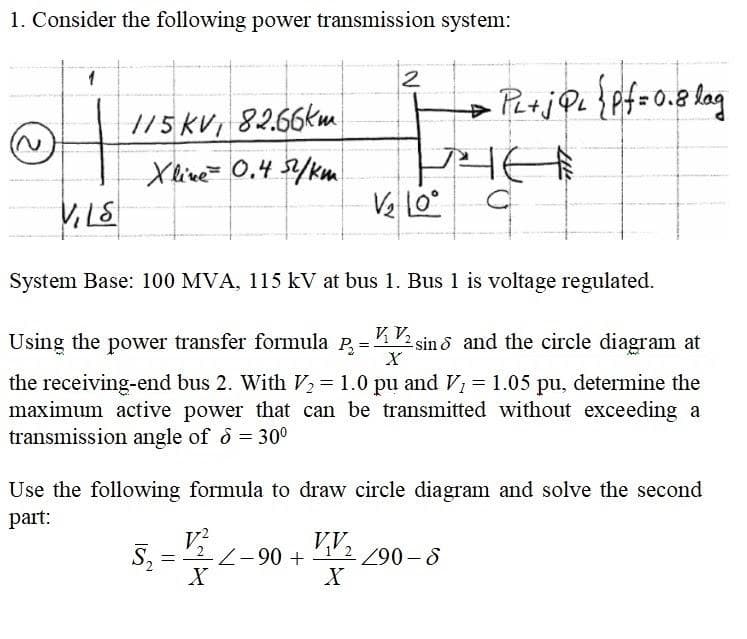//5 KV, 82.6bem 2. Xline= 0.4 3/km HE System Base: 100 MVA, 115 kV at bus 1. Bus 1 is voltage regulated. V V, Using the power transfer formula P,=2 sin d and the circle diagram at X the receiving-end bus 2. With V = 1.0 pu and V= 1.05 pu, determine the maximum active power that can be transmitted without exceeding a transmission angle of o = 30° Use the following formula to draw circle diagram and solve the second part: V? = 2 2-90 + VV, 2290-6
//5 KV, 82.6bem 2. Xline= 0.4 3/km HE System Base: 100 MVA, 115 kV at bus 1. Bus 1 is voltage regulated. V V, Using the power transfer formula P,=2 sin d and the circle diagram at X the receiving-end bus 2. With V = 1.0 pu and V= 1.05 pu, determine the maximum active power that can be transmitted without exceeding a transmission angle of o = 30° Use the following formula to draw circle diagram and solve the second part: V? = 2 2-90 + VV, 2290-6
Introductory Circuit Analysis (13th Edition)
13th Edition
ISBN:9780133923605
Author:Robert L. Boylestad
Publisher:Robert L. Boylestad
Chapter1: Introduction
Section: Chapter Questions
Problem 1P: Visit your local library (at school or home) and describe the extent to which it provides literature...
Related questions
Question
answer all

Transcribed Image Text:1. Consider the following power transmission system:
Perj@e {pf=0.8 tag
//5 kV, 82.66km
Xline= 0.4 /km
(2)
System Base: 100 MVA, 115 kV at bus 1. Bus 1 is voltage regulated.
Using the power transfer formula P,
sin d and the circle diagram at
the receiving-end bus 2. With V, = 1.0 pu and V; = 1.05 pu, determine the
maximum active power that can be transmitted without exceeding a
transmission angle of o = 30°
Use the following formula to draw circle diagram and solve the second
part:
S,
V2 /90-8
Expert Solution
This question has been solved!
Explore an expertly crafted, step-by-step solution for a thorough understanding of key concepts.
This is a popular solution!
Trending now
This is a popular solution!
Step by step
Solved in 2 steps with 2 images

Knowledge Booster
Learn more about
Need a deep-dive on the concept behind this application? Look no further. Learn more about this topic, electrical-engineering and related others by exploring similar questions and additional content below.Recommended textbooks for you

Introductory Circuit Analysis (13th Edition)
Electrical Engineering
ISBN:
9780133923605
Author:
Robert L. Boylestad
Publisher:
PEARSON

Delmar's Standard Textbook Of Electricity
Electrical Engineering
ISBN:
9781337900348
Author:
Stephen L. Herman
Publisher:
Cengage Learning

Programmable Logic Controllers
Electrical Engineering
ISBN:
9780073373843
Author:
Frank D. Petruzella
Publisher:
McGraw-Hill Education

Introductory Circuit Analysis (13th Edition)
Electrical Engineering
ISBN:
9780133923605
Author:
Robert L. Boylestad
Publisher:
PEARSON

Delmar's Standard Textbook Of Electricity
Electrical Engineering
ISBN:
9781337900348
Author:
Stephen L. Herman
Publisher:
Cengage Learning

Programmable Logic Controllers
Electrical Engineering
ISBN:
9780073373843
Author:
Frank D. Petruzella
Publisher:
McGraw-Hill Education

Fundamentals of Electric Circuits
Electrical Engineering
ISBN:
9780078028229
Author:
Charles K Alexander, Matthew Sadiku
Publisher:
McGraw-Hill Education

Electric Circuits. (11th Edition)
Electrical Engineering
ISBN:
9780134746968
Author:
James W. Nilsson, Susan Riedel
Publisher:
PEARSON

Engineering Electromagnetics
Electrical Engineering
ISBN:
9780078028151
Author:
Hayt, William H. (william Hart), Jr, BUCK, John A.
Publisher:
Mcgraw-hill Education,